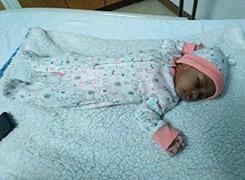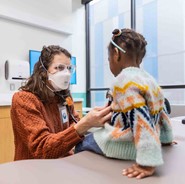 Amna and her family moved to Seattle to get the best treatment possible for her daughter Jude, who has sickle cell disease. This is Amna’s story in her own words.
Amna and her family moved to Seattle to get the best treatment possible for her daughter Jude, who has sickle cell disease. This is Amna’s story in her own words.
I will never forget the moment I learned I was pregnant with my daughter, Jude. I had moved from Sudan to join my husband, Amar, in the United States the year before. In my culture, we have big families with lots of kids, and Amar and I wanted to start our own family right away.
It took a long time for me to get pregnant, but when I finally did, I felt like I was flying! I named my baby Jude that day. In Arabic, it means “the gift.” She was my gift from God.
Back then, I never imagined my baby’s life would be at risk before she reached her first birthday.
Jude was born in Omaha, Nebraska, in 2019. After two days of labor, she finally came out. It was amazing. She was so beautiful. But a few days later, after her newborn screening tests, we found out Jude had sickle cell disease.
I didn’t know anything about SCD then, but I soon learned it was a genetic disorder in which red blood cells can block oxygen to parts of the body. Patients with this disease live with severe pain, are vulnerable to infections and can develop many life-threatening conditions.
Children inherit the genes that cause SCD from both their mother and their father. Knowing Jude’s disease had come from us, Amar and I blamed ourselves. For months, I was terribly depressed. I would look at my daughter and then go online and read about all the things that might happen to her.
Standing up for Jude

It was so hard for me to accept Jude’s diagnosis, but I knew I had to take care of her the best I could. I went to Jude’s doctor in Omaha and asked for books and other resources. I took notes and brought questions to every appointment. Her providers tried to answer my questions, but they were not sickle cell experts, and their knowledge of the disease was limited.
I began researching SCD care centers around the country and asked Jude’s doctor where she would get the best care. He recommended Seattle Children’s Sickle Cell Disease Program.
I later learned Seattle Children’s Odessa Brown Children’s Clinic and the hospital’s Cancer and Blood Disorders Center had more experience caring for children with SCD than any other program in the Pacific Northwest.
Still, moving to Seattle seemed impossible. I was still learning to speak English and relied heavily on my Arabic-speaking family and friends in Omaha. I had my driver’s license but had only driven alone a couple times. I wasn’t ready to leave my community.
But Jude’s health was deteriorating. At first, I kept her inside and away from other kids, but when she was 4 months old, I took Jude to a park with a friend. By that afternoon, she had a fever over 100 degrees. Jude was hospitalized for a week and had her first blood transfusion. I sat by her bedside crying. Whatever pain she was feeling, I felt it too. I was desperate to take it away from her.
Sickle cell disease health outcome disparities
Information courtesy of the CDC Foundation and the American Stroke Association. |
Two months later, we took Jude back to the hospital because there was something wrong with her spleen. Again, I cried while she had a second blood transfusion.
I could see what this disease was costing Jude. I felt like she was dying in front of my eyes.
That day, I called Amar and told him we needed to move to Seattle.
A difficult transition
Jude and I arrived in Seattle in March 2020, just as the COVID-19 pandemic was becoming more serious. Amar had gone to Seattle first to start working and find us an apartment, but a few months into the pandemic, he was laid off. We worried about how we would pay for Jude’s care.
To make things worse, Jude was hospitalized again shortly after we arrived in Seattle. She was 8 months old and already having her third blood transfusion.
I began to feel the weight of being alone in a new city. I didn’t know anyone here—certainly no one who understood what it was like to have a child with SCD. If I cried, there weren’t any shoulders to cry on.

But things changed when we took Jude to OBCC. We first met with Alix Dassler, the sickle cell team’s nurse practitioner. Before we moved to Seattle, I called Alix with question after question, and she answered them all. In the clinic, I told her, “I need to feel I’m not alone.” I needed to meet other families who had grown children with SCD so I could see my daughter’s future.
Alix connected me to the Metropolitan Seattle Sickle Cell Task Force, and I began meeting with families who understood what I was going through.
At the same time, Dr. Michael Bender, director of OBCC’s Sickle Cell Clinic, recommended a medication for Jude called Hydroxyurea. This magic medicine makes red blood cells bigger and rounder. It changed Jude’s life. She grew significantly, had less pain and swelling and was more playful.
Pain in sickle cell diseasePatients with SCD experience the trauma of severe pain and are exposed to opioids at an early age — typically as young as 6 months old. Research shows providers consistently overestimate the risk of addiction for patients with sickle cell disease compared with other chronic pain syndromes, despite evidence that there is not a greater risk of addiction for these patients. As a result, patients with SCD often experience longer wait times to see a doctor and get pain medication. For these reasons, patients sometimes choose not to seek needed medical care. Information courtesy of Dr. Marsha Treadwell, professor of pediatrics, Division of Hematology, Jordan Endowed Chair, University of California. Learn more about SCD health disparities in Dr. Treadwell’s webinar “Improving the Quality of Sickle Cell Disease Care by Understanding and Addressing Healthcare,” hosted by Children’s Center for Diversity and Health Equity. |
Sarah Wandler, a social worker at OBCC, helped us navigate our financial challenges. She connected us to community resources that provided food, diapers and four months of rent. Meanwhile, Seattle Children’s Uncompensated Care Program covered the cost of Jude’s medical care.
It was such a relief to know Jude’s treatment would not cost us. I realized we were not alone, after all. Someone cared about our situation.
When Amar started working again, leaving me home alone with Jude, Sarah helped my mother get a visa so she could travel from Turkey and stay with me for six months.
Finding myself
Jude has not been hospitalized since starting the Hydroxyurea treatment nearly two years ago. As her health improved, I was able to go back to school. I’m currently studying at North Seattle College, with the help of my tutor, Lara Backman, to earn a bachelor’s degree in epidemiology. My classes help me better understand Jude’s disease, and I’m sharing my knowledge with a group of other Arabic-speaking families in my community who have children with sickle cell disease.
When I first learned Jude had SCD, I thought our lives were going to stop, but I was wrong. Today, I see how strong we are. Jude is growing, and I am growing with her.
Seattle Children’s sickle cell team saved my daughter’s life. They helped me to find myself. When I felt utterly alone, Alix, Dr. Bender and Sarah cared about my situation. They became my backbone, my family.
I want other parents who have children with SCD to know there is hope. With a good care team and good medicine, their children can enjoy life just like Jude is.
Growing Seattle Children’s Sickle Cell ProgramSeattle Children’s is committed to growing the Sickle Cell Program into a center of excellence with additional team members and resources over the next five years. The Guild Association has committed to supporting this effort by raising $1.5 million this year. Sickle cell disease research is a fundraising priority for Seattle Children’s Foundation. To donate, visit give.seattlechildrens.org and write “Sickle Cell Disease Research” in the “Direct my donation to” field of the donation form. |

